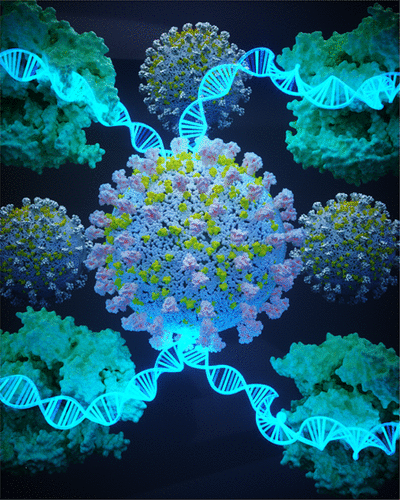Our official English website, www.x-mol.net, welcomes your
feedback! (Note: you will need to create a separate account there.)
CRISPR Systems for COVID-19 Diagnosis
ACS Sensors ( IF 8.2 ) Pub Date : 2021-01-27 , DOI: 10.1021/acssensors.0c02312 Hossein Rahimi 1, 2 , Marziyeh Salehiabar 3, 4 , Murat Barsbay 5 , Mohammadreza Ghaffarlou 5 , Taras Kavetskyy 4, 6, 7 , Ali Sharafi 2, 4 , Soodabeh Davaran 3, 4 , Subhash C Chauhan 8, 9 , Hossein Danafar 2, 4 , Saeed Kaboli 1 , Hamed Nosrati 2, 4 , Murali M Yallapu 8, 9 , João Conde 10, 11
ACS Sensors ( IF 8.2 ) Pub Date : 2021-01-27 , DOI: 10.1021/acssensors.0c02312 Hossein Rahimi 1, 2 , Marziyeh Salehiabar 3, 4 , Murat Barsbay 5 , Mohammadreza Ghaffarlou 5 , Taras Kavetskyy 4, 6, 7 , Ali Sharafi 2, 4 , Soodabeh Davaran 3, 4 , Subhash C Chauhan 8, 9 , Hossein Danafar 2, 4 , Saeed Kaboli 1 , Hamed Nosrati 2, 4 , Murali M Yallapu 8, 9 , João Conde 10, 11
Affiliation

|
The emergence of the new coronavirus 2019 (COVID-19) was first seen in December 2019, which has spread rapidly and become a global pandemic. The number of cases of COVID-19 and its associated mortality have raised serious concerns worldwide. Early diagnosis of viral infection undoubtedly allows rapid intervention, disease management, and substantial control of the rapid spread of the disease. Currently, the standard approach for COVID-19 diagnosis globally is the RT-qPCR test; however, the limited access to kits and associated reagents, the need for specialized lab equipment, and the need for highly skilled personnel has led to a detection slowdown. Recently, the development of clustered regularly interspaced short palindromic repeats (CRISPR)-based diagnostic systems has reshaped molecular diagnosis. The benefits of the CRISPR system such as speed, precision, specificity, strength, efficiency, and versatility have inspired researchers to develop CRISPR-based diagnostic and therapeutic methods. With the global COVID-19 outbreak, different groups have begun to design and develop diagnostic and therapeutic programs based on the efficient CRISPR system. CRISPR-based COVID-19 diagnostic systems have advantages such as a high detection speed (i.e., 30 min from raw sample to reach a result), high sensitivity and precision, portability, and no need for specialized laboratory equipment. Here, we review contemporary studies on the detection of COVID-19 based on the CRISPR system.
中文翻译:

用于 COVID-19 诊断的 CRISPR 系统
2019新型冠状病毒(COVID-19)于2019年12月首次出现,并迅速传播并成为全球大流行病。COVID-19 病例数量及其相关死亡率已引起全世界的严重关注。病毒感染的早期诊断无疑可以实现快速干预、疾病管理和实质性控制疾病的快速传播。目前,全球COVID-19诊断的标准方法是RT-qPCR检测;然而,试剂盒和相关试剂的获取有限、对专业实验室设备的需求以及对高技能人员的需求导致检测速度放缓。最近,基于成簇规则间隔短回文重复(CRISPR)的诊断系统的发展重塑了分子诊断。CRISPR系统的速度、精确度、特异性、强度、效率和多功能性等优点激励研究人员开发基于CRISPR的诊断和治疗方法。随着全球COVID-19的爆发,不同的团体开始设计和开发基于高效CRISPR系统的诊断和治疗方案。基于CRISPR的COVID-19诊断系统具有检测速度快(即从原始样本开始30分钟即可得出结果)、高灵敏度和精确度、便携性以及不需要专门的实验室设备等优点。在此,我们回顾一下基于 CRISPR 系统检测 COVID-19 的当代研究。
更新日期:2021-01-27
中文翻译:

用于 COVID-19 诊断的 CRISPR 系统
2019新型冠状病毒(COVID-19)于2019年12月首次出现,并迅速传播并成为全球大流行病。COVID-19 病例数量及其相关死亡率已引起全世界的严重关注。病毒感染的早期诊断无疑可以实现快速干预、疾病管理和实质性控制疾病的快速传播。目前,全球COVID-19诊断的标准方法是RT-qPCR检测;然而,试剂盒和相关试剂的获取有限、对专业实验室设备的需求以及对高技能人员的需求导致检测速度放缓。最近,基于成簇规则间隔短回文重复(CRISPR)的诊断系统的发展重塑了分子诊断。CRISPR系统的速度、精确度、特异性、强度、效率和多功能性等优点激励研究人员开发基于CRISPR的诊断和治疗方法。随着全球COVID-19的爆发,不同的团体开始设计和开发基于高效CRISPR系统的诊断和治疗方案。基于CRISPR的COVID-19诊断系统具有检测速度快(即从原始样本开始30分钟即可得出结果)、高灵敏度和精确度、便携性以及不需要专门的实验室设备等优点。在此,我们回顾一下基于 CRISPR 系统检测 COVID-19 的当代研究。











































 京公网安备 11010802027423号
京公网安备 11010802027423号